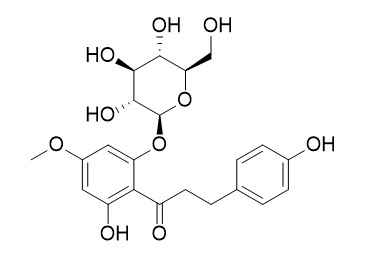Asebotin
Asebotin shows anti-influenza A virus activity, it also possesses potent antiviral activity (100% inhibition at the concentration of 1 ug /mL) against highly pathogenic avian influenza strain H5N1. Asebotin can inhibit the proliferation of murine B cells.
Inquire / Order:
manager@chemfaces.com
Technical Inquiries:
service@chemfaces.com
Tel:
+86-27-84237783
Fax:
+86-27-84254680
Address:
1 Building, No. 83, CheCheng Rd., Wuhan Economic and Technological Development Zone, Wuhan, Hubei 430056, PRC
Providing storage is as stated on the product vial and the vial is kept tightly sealed, the product can be stored for up to
24 months(2-8C).
Wherever possible, you should prepare and use solutions on the same day. However, if you need to make up stock solutions in advance, we recommend that you store the solution as aliquots in tightly sealed vials at -20C. Generally, these will be useable for up to two weeks. Before use, and prior to opening the vial we recommend that you allow your product to equilibrate to room temperature for at least 1 hour.
Need more advice on solubility, usage and handling? Please email to: service@chemfaces.com
The packaging of the product may have turned upside down during transportation, resulting in the natural compounds adhering to the neck or cap of the vial. take the vial out of its packaging and gently shake to let the compounds fall to the bottom of the vial. for liquid products, centrifuge at 200-500 RPM to gather the liquid at the bottom of the vial. try to avoid loss or contamination during handling.
Nutrients.2024, 16(14):2267.
Nat Chem Biol.2018, 14(8):760-763
Plant Growth Regulation2020, 90(2):383-392
ACS Omega.2023, 8(36):32424-32431.
The Journal of Agromedicine and Medical Sciences2018, 4(1)
J Am Soc Mass Spectrom.2021, 32(5):1205-1214.
Bio-protocol2018, 9(14):e3301
National University of Pharmacy2022, 1:73-76
Food Funct.2022, 13(13):6923-6933.
US20170000760 A12016, 42740
Related and Featured Products
Nat Prod Res. 2014;28(6):377-82.
Anti-influenza A virus activity of a new dihydrochalcone diglycoside isolated from the Egyptian seagrass Thalassodendron ciliatum (Forsk.) den Hartog.[Pubmed:
24443884]
METHODS AND RESULTS:
One new dihydrochalcone diglycoside has been isolated from the EtOAc fraction of the Egyptian seagrass Thalassodendrin ciliatum (Forsk.) den Hartog, and was identified as 6'-O-rhamnosyl-(1‴ → 6″)-glucopyranosyl asebogenin for which a trivial name Thalassodendrone was established. Furthermore, five known phenolics were isolated and identified as Asebotin, quercetin 3,7-diglucoside, protocatechuic acid, ferulic acid and p-hydroxybenzoic acid. The structures of all the isolated compounds were established based on 1D and 2D NMR spectroscopy and high-resolution-mass spectrometer. High-resolution electrospray ionization mass spectra (HR-ESI-MS) were obtained using a JEOL JMS-T100TD spectrometer (JEOL Ltd., Tokyo, Japan).
CONCLUSIONS:
The anti-influenza A virus activity of the isolated new compound and Asebotin was evaluated, and the obtained results revealed that the inhibition dose concentration of Asebotin was more than that of Thalassodendrone with IC50 = 2.00 and 1.96 μg/mL, respectively, and with cytotoxic concentration (CC50) of 3.36 and 3.14 μg/mL, respectively.
Nat Prod Res. 2013;27(18):1625-32.
Anti-H5N1 virus new diglyceride ester from the Red Sea grass Thallasodendron ciliatum.[Pubmed:
23163517 ]
METHODS AND RESULTS:
Some Egyptian plants were screened against highly pathogenic avian influenza strain H5N1 using plaque inhibition assay in Madin-Darby canine kidney. The results indicated that the extracts of Red Sea grass Thallasodendron ciliatum possessed potent antiviral activity (100% inhibition at the concentration of 1 μg mL⁻1). The bioactivity-guided fractionations led to the isolation of a new diglyceride ester (1) along with Asebotin (2) for the first time from the plant.
CONCLUSIONS:
The two isolates showed reduction of virus titre by 67.26% and 53.81% inhibition at concentration of 1 ng mL⁻1, respectively.
J Nat Prod. 2005 Mar;68(3):392-6.
Dihydrochalcones from the leaves of Pieris japonica.[Pubmed:
15787442 ]
METHODS AND RESULTS:
Six new dihydrochalcones, 3-hydroxyAsebotin (5), asebogenin 2'-O-beta-D-ribohexo-3-ulopyranoside (6), 2' '-acetylAsebotin (7), 3',4,5'-trihydroxy-4'-methoxydihydrochalcone 3',5'-di-O-beta-D-glucopyranoside (8), and pierotins A (9) and B (10), along with four known dihydrochalcones, phloretin (1), phlorizin (2), asebogenin (3), and Asebotin (4), were isolated from the leaves of Pieris japonica. Their structures were elucidated on the basis of spectroscopic analysis including HMQC, HMBC, NOESY, and X-ray crystal diffraction.
CONCLUSIONS:
Compounds 1, 3-5, and 7-10 inhibited the proliferation of murine B cells and compounds 5 and 10 inhibited the proliferation of murine T cells in vitro significantly.



